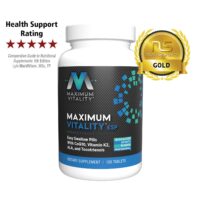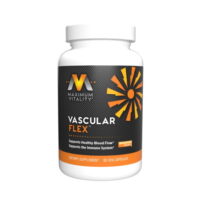After reaching adulthood, bone loss occurs naturally as we age. With sufficient vitamin D3 and vitamin K2 intake, this loss can be slowed or reversed.
This article will describe how bone health is related to blood and vascular health. Thus, skeletal health is critical for cognitive function, sports activities, minimizing minor occasional pain and excelling at all the activities that you cherish most.
Bone Metabolism
Poor bone metabolism is a condition characterized by loss of bone mineral density, which leads to bone that is weaker and more susceptible to fractures. According to the World Health Organization (WHO), one in three men is expected to incur bone fractures in the future because of poor bone metabolism, whereas lifetime risk of fracture for women is nearly one in two.
Bone is a living substance comprised of a hard outer shell, spongy inner tissue matrix, and surprisingly its own vascular system. The skeleton “remodels” itself every 8 to 12 years. Remodeling bone is the term used for replacing bone. This process is regulated by osteoblasts (cells that build up bone) and osteoclasts (cells that break down bone). Osteoblasts produce a protein called Osteocalcin, a vitamin K-dependent protein that binds calcium to the bone matrix and builds healthy bones. But Osteocalcin needs adequate Vitamin K2 to activate it.1
As long as bone-forming activity (absorption) is equal to bone-breakdown (resorption), the process of maintaining healthy bones is considered healthy bone turnover. However, when this delicate process is not in balance, bones become weak and brittle. This is an unfortunate result of Vitamin K2 deficiency.
The strong association between Vitamin K2 deficiency and impaired bone health was proven in both laboratory and clinical studies. It has been found that vitamin K2 deficiency results in a decreased level of active Osteocalcin, which in turn increases the risk for fragile bones.2,3 Research has shown that Vitamin K2 – but not K1 – combined with calcium, other cofactors, and vitamin D can increase bone turnover.4 Further, a significant study clearly demonstrated that Vitamin K2 is essential for maintaining bone strength in postmenopausal women, and also improved bone mineral content and femoral neck width.5
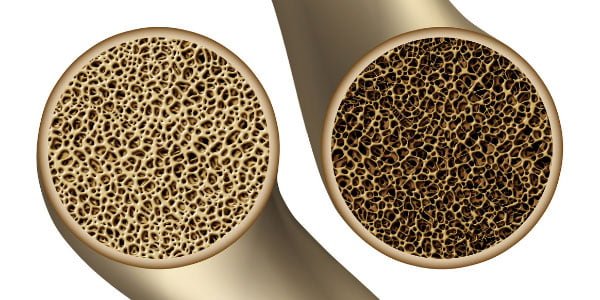
In 2013, Osteoporosis International published a groundbreaking double-blind, randomized, clinical trial that demonstrated statistically significant protection of the vertebrae and the hip (femoral neck) against bone loss in humans.6 This was attained with a nutritional dose of Vitamin K2 as MK-7 (MenaQ7® brand) taken daily for three years.
In this study of 244 healthy post-menopausal women, the MenaQ7® group took 180 mcg daily and showed significantly decreased circulating uncarboxylated osteocalcin (ucOC), a well-established biomarker for bone and vitamin K status. After 3 years, both bone mineral content and bone mineral density, as well as bone strength were statistically significantly better for the MK-7 group compared to the placebo group.
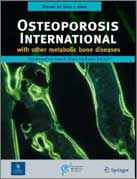
Blood Circulation in Bones
Do you know that there is a blood circulation system in your bones? Your doctor probably does not either. It was discovered and published in 2019! Imagine, scientists are still discovering new physical circulatory systems in the human body.
Previously overlooked, a network of very fine blood vessels that connect bone marrow directly with the blood supply of the periosteum (a dense layer of vascular connective tissue enveloping the bones) was discovered by Dr. Anika Grüneboom, a young researcher working at Universitätsklinikum Erlangen. She published this groundbreaking discovery in 2019, while working on her doctoral thesis at Universität Duisburg-Essen (UDE) with Prof. Dr. Matthias Gunzer.
Although bones seem very hard, they have a dense network of blood vessels inside them where the bone marrow is located, as well as on the outside covered by the periosteum. New blood cells leave bone marrow via this system of vessels to circulate in the body.
“As with every organ, bones need a closed bloodstream for these functions. While fresh blood is transported into organs via arteries, veins transport the ‘used’ blood back out again. The precise structure of this closed bloodstream in long bones was not clear up to now,” explains Dr. Anika Grüneboom, Department of Medicine – Rheumatology and Immunology at Universitätsklinikum Erlangen.
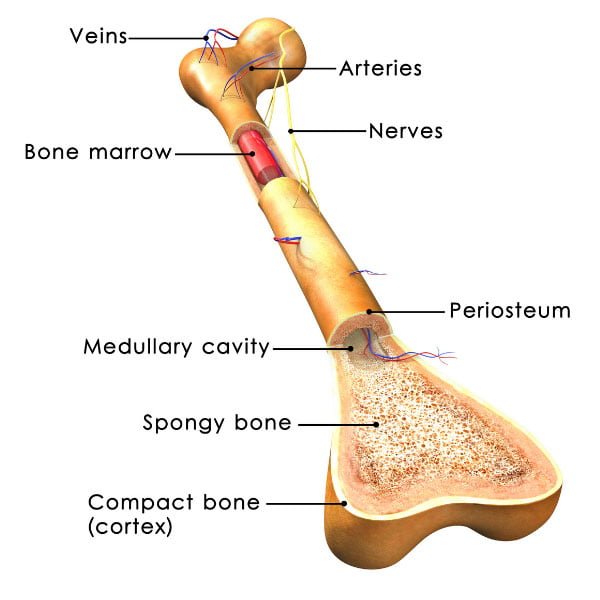
Over one thousand blood vessels in some bones
The European researchers have found thousands of previously unknown blood vessels in the bones of mice that traverse perpendicularly across the entire length of the compact bone, the so-called cortical bone. The researchers have named them ‘trans-cortical vessels’ (TCVs). Furthermore, they were able to demonstrate that the majority of both arterial and venous blood flows through this newly discovered system of vessels. This means that the system is a central component for supplying bones with oxygen and nutrients.
In addition, the researchers discovered that the newly discovered system of blood vessels is used by new immune cells which grow in bone marrow to reach the bloodstream. In the case of inflammation, it is especially important that immune cells reach the source of the inflammation quickly.
Senior researcher, Prof. Gunzer, commented: “Previous scientific research only described a few arterial canals and two venous canals in bones. This is completely inaccurate and does not reflect the actual situation at all. It is quite surprising that we can still find new anatomic structures in the 21st century that are not found in any textbooks.” The discovery was possible due to a unique combination of modern imaging methods explains Prof. Gunzer: “Many of these methods were used for the very first time by us such as light-sheet fluorescence microscopy and ultra high-resolution tesla (T) magnetic resonance imaging and x-ray microscopy in collaboration with the ERC Synergy Grant 4D-nanoSCOPE team under the leadership of Prof. Dr. Silke Christiansen and Prof. Dr. Georg Schett.”
Recommended Bone Health Supplements to Support Skeletal Health
Basic Bone Building Blocks (B4) include Calcium, Magnesium, Manganese Copper, Zinc, and Boron. You will find all these minerals in a reasonably healthy diet and in a sophisticated multivitamin such as Maximum Vitality®.
Who would have thought bones both need and provide vascular support?
Vascular Flex™ contains 5,000 IU vitamin D3 and 180 mcg vitamin K2 as MK7 branded MenaQ7®. Not only does it support healthy blood flow to and within bones, it provides sophisticated support for healthy bone structure and function as described above.
References
- Vergnaud P, Garnero P, et.al. Undercarboxylated osteocalcin measured with a specific immunoassay predicts hip fracture in elderly women: the EPIDOS Study. J Clin Endocrinol Metab. 1997;82(3):719-24.
- Booth SL, Broe KE, et.al. Associations between K vitamins biochemical measures and bone mineral density in men and women. J Clin Endocrinol Metab. 2004;89(10):4904-9.
- Knapen MH, Nieuwenhuijzen Kruseman AC, et.al. Correlation of serum osteocalcin fractions with bone mineral density in women during the first 10 years after menopause. Calcif Tissue Int. 1998;63(5):375-9.
- Schurgers LJ, Knapen MH, Vermeer C. K vitamin supplementation improves hip bone geometry and bone strength indices in postmenopausal women. Int. Congr. Series 2007; 179-187.
- Knapen MH, Schurgers LJ, Vermeer C. Vitamin K2 supplementation improves hip bone geometry and bone strength indices in postmenopausal women. Osteoporos Int. 2007;18(7):963-72.
- Knapen MHJ, Drummen NE, et.al. Three-year low-dose menaquinone-7 supplementation helps decrease bone loss in healthy postmenopausal women. Osteoporosis Int. 2013 Sep;24(9):2499-507.
- Grüneboom A, Gunzer M, et.al. A network of trans-cortical capillaries as mainstay for blood circulation in long bones. Nature Metabolism, 2019; DOI: 10.1038/s42255-018-0016-5


